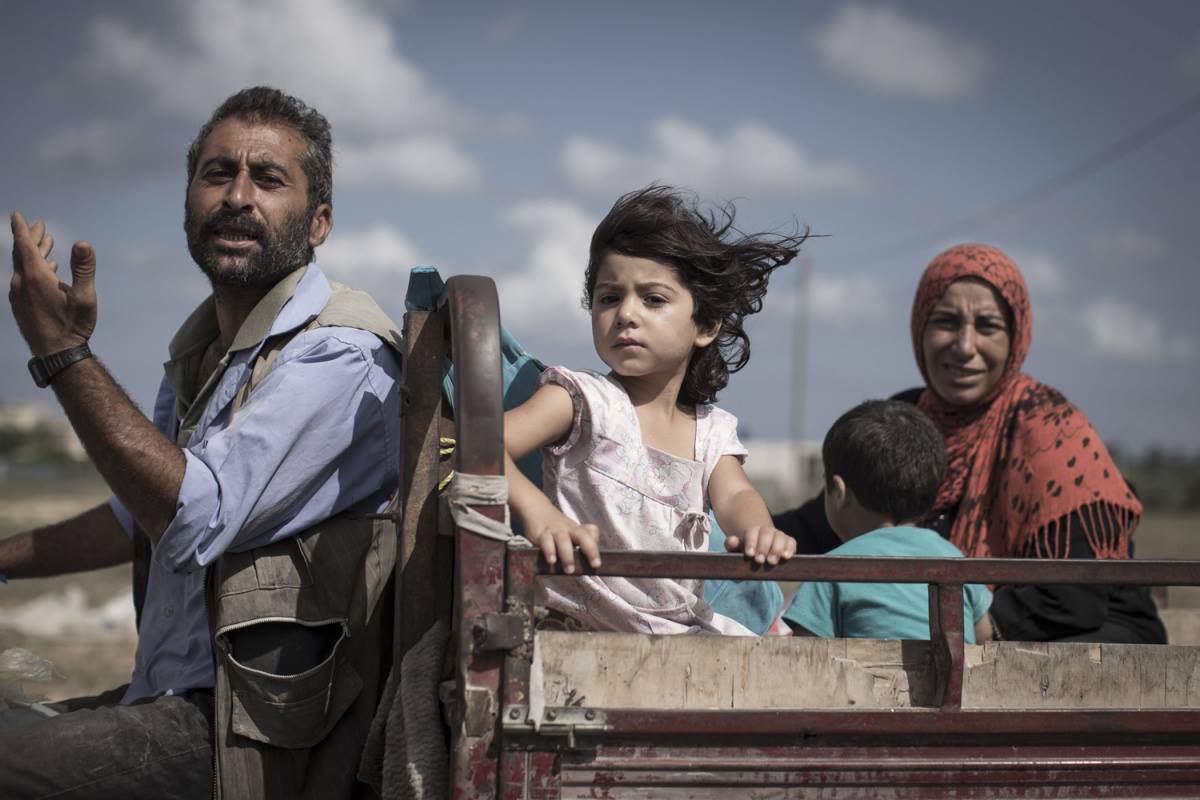What’s the Israeli plan with all of this? According to the Israeli Defense Forces statement, “The IDF’s objective as defined by the Israeli government (in the ground offensive) is to establish a reality in which Israeli residents can live in safety and security without continuous indiscriminate terror, while striking a significant blow to Hamas’ terror infrastructure.”
Despite the somewhat ambiguous language here, what this apparently means is that the Israeli government wants to return to some kind of status-quo ante — albeit one with a weakened Hamas stockpile of rockets and tunnels. It doesn’t want to return to full-scale occupation in Gaza and it doesn’t want to defeat Hamas. Both would be too costly. As Aaron David Miller writes :
Israel needs Hamas in Gaza. Of course, it doesn’t want a militant terrorist organization launching rockets at its cities and citizens. But a Hamas that maintains order there and provides a hedge against even more radical jihadi groups is preferable to a lawless vacuum. Indeed, fewer rockets were fired from Gaza in 2013 than in any year since 2001. I’ve often pondered why al Qaeda has never been able to set up shop in an effective manner in Gaza, or undertake a terrorist extravaganza in Israel. The absence of an al Qaeda presence is not only a result of the Israeli security presence — it’s due to the determination of Palestinians not to allow the jihadists to hijack their cause. The absence of an al Qaeda presence is not only a result of the Israeli security presence — it’s due to the determination of Palestinians not to allow the jihadists to hijack their cause…
…The last thing Israel wants is a vacuum in Gaza.
But, while the status quo ante may be acceptable to Israelis, it almost certainly is not possible.
The immediate humanitarian effects of the Hamas-Israeli military violence over the past two weeks have been disastrous:
Between July 7 and 16, Israel’s bombardment of Gaza killed 214 Palestinians (164 of whom were civilians) and injured 1,585 (including 435 children and 282 women). To date, 22,600 people have been displaced and are living in UN Relief and Works Agency (UNRWA) schools, because their homes have been destroyed or damaged or their neighborhoods are unsafe. Since the start of the emergency, 79 schools and 23 health care facilities in Gaza have sustained damage, at least 25,000 children are estimated to be in need of specialized psychosocial support, and 900,000 people are currently without water supply.
But, even before the recent escalation, Gazans were experiencing an acute humanitarian crisis. At the only border crossing between Israel and Gaza at Karem Shalom only 250 trucks transit into Gaza from Israel each day. Clearly, not nearly enough to provide all of the food, clothing, medicine, and other daily materials to support Gaza’s 1.8 million residents. And while the intensity of the blockade on Gaza has ebbed and flowed over the past nine years, as Pia Wanak further reports, the collective effects of the blockade have been profound:
Around 60 percent of the population is food insecure and about 50 percent of household income is spent on food. Israel bulldozed one-third of the arable land of the Gaza Strip in 2001 to create a buffer zone that runs the length of the Strip, which has led to an estimated reduction of 75,000 metric tons of produce each year. Fishing, a major industry that had employed 35,000 Gazans, was reduced drastically when Israel restricted fishermen to six nautical miles of the Mediterranean, the same water which receives 90 million liters of untreated or partially treated sewage each day.
It has been estimated that by 2020, the population of Gaza will be 2.1 million and that by 2016, Gazans will run out of potable water. Unless there is a change in the political status quo, the humanitarian crisis in the Gaza Strip will continue to worsen even when the current conflict ends.
Furthermore, according to the Norwegian Refugee Council:
A mere ‘return to calm’ will not address the pre-existing humanitarian crisis and will not allow humanitarian agencies to provide adequate assistance to those affected by the latest spiral of violence, exacerbated by the ground invasion. Against the backdrop of the eight-year-long blockade, which has caused severe deterioration in the humanitarian situation, structural and lasting solutions will have to be implemented to ensure that the residents of the Gaza Strip are not forced to return to the status quo.
So, this gets us back to the basic question: What’s the Israeli plan with all of this? Even if the IDF is able to accomplish its most immediate objective and strike a “blow at Hamas’s terrorist infrastructure,” then what? What’s the plan for the day after? What’s the plan to alleviate the long-term affects of the on-going humanitarian crisis — and in the absence of such a plan, how can the Israel and the IDF really achieve its objective to “establish a reality in which Israeli residents can live in safety and security?”
Jon Western has spent the last fifteen years teaching IR in liberal arts colleges at Mount Holyoke College and the Five Colleges in western Massachusetts. He has an eclectic range of intellectual interests but often writes on international security, U.S. foreign policy, military intervention, and human rights. He occasionally shares his thoughts about professional life in liberal arts colleges. In his spare time he coaches middle school soccer, mentors the local high school robotics team, skis, and sails.



Israel’s general plan is ethnic cleansing; in the WB and in the GS. The former by way of settlements and withdrawal of passports/paperwork (do you know how many WB Palestinians have obtained the right to go to Jordan and never been allowed to return?), the latter by way of bombing and making life so unbearable that people leave. If you doubt this, strip the word ‘Israel’ from any report you see on Gaza and replace it with your favourite enemy; ‘Iraq,’ ‘Iran,’ ‘etc,’ and interpret what you see.
Your argument is that Israel closes off a border and has Egypt do the same, controls airspace and territorial waters, all as part of a plan for everyone in this “open-air prison” to LEAVE?
Please make up your mind. Is it an open-air prison or a really, really slow deportation center? How do the people living this unbearable Gazan life get past the border to not be allowed back?
For such an evil ethnic-cleansing military behemoth, Israel sure sucks at ethnic cleansing when the population of Gaza just keeps increasing. I mean, despite killing a thousand people in a military operation every four years or so, somehow a population of 1.8 million keeps growing. The math is just astounding. Maybe the IDF is bad at math. Maybe they don’t know that a thousand fatalities in a military incursion, while tragic, doesn’t make a dent in a growing population.
Or maybe you should reconsider a better way of matching motives to outcomes.
The difficulty here is your lack of historical perspective. Most people in Gaza are refugees. They have already been ethnically cleansed and are being kept in their place by Israeli bombing (apart from the obvious domestic currency of killing Arabs). In addition, Israel deliberately makes life so pointless in the WB/GS that those with the ability to leave do leave (foreign passport holders, those who can get permits in between fighting, etc.).
So your argument isn’t that the war on Gaza is ethnic cleansing of Gaza, but that it’s follow-up on earlier ethnic cleansing to ensure the ethnically-cleansed population remains in Gaza rather than Israel proper (or the WB, presumably)?
But then why not let them leave, and stop them from coming back, as you argue they do in the WB? Getting out of Gaza is not easy for Palestinians and usually requires medical necessity or political reasons. Surely having them start new lives in Europe, America, Arab world, wherever is much more convenient for Israel than having to deal with an ever-larger population directly on its borders?
I am just trying to figure out how your mind works, mind you.
I think it’s clear that there isn’t a plan(in Israel) to help develop the circumstances where “a reality in which Israeli(and Palestinian) residents can live in safety and security” can be established. Whether this is because of electoral concerns, domestic politics,
institutional dysfunction, irredentist insanity or whatever, this is the
clear reality. Again, this is an outcome that can be achieved only by internationalising the conflict sufficiently, threatening to seriously sanction Israel and forcing a resolution on them.
Since this is primarily a US blog shouldn’t the question be, how can US policy help move towards a solution ? (Or to paraphrae Madeleine Albright, “what’s the point of havin’ all this hegemony if you ain’t gonna use it?”)
“Kicking the can down the road” is a longtime Israeli strategy, to dignify it beyond what it deserves. If the IDF does a thorough job on the tunnels, the influx of missiles will be drastically curtailed. As for the suffering population, well, that’s a Hamas problem.
They call it “mowing the lawn,” there, which in its crassness says a lot.
As others have pointed out, the suffering population isn’t necessarily just a Hamas problem, especially if more people are led to take up rocketeering as a hobby, or if the supposed international community decides to get more involved.
You are a callous individual!And not very bright.
I don’t favour either side,only justice,I think you can’t see past a few years.Long term prognosis not good for the violent party!
Gazan children will have a memory.Someday not too far in the future,balance in strength between foe and prey will balance.Stamina and ability to withstand punishment and sacrifice will win.Pain makes one tougher.
Israel will eventually buckle under the weight of the rising Palestinian population,even if they have military superiority.Long term prognosis-?
Israelis and Jews are an admirable people and have contributed a lot to the world.
I just hope they are as just are as as they are smart.Their eventual survival depends on this.